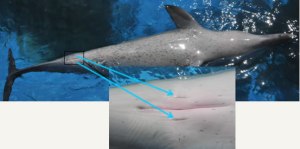
by chelsea schuyler

I was once asked, “How do dolphins deal with umbilical cords?” and I was not unlike Keanu Reeves in staring blanking and thinking, “Whoa.” How does that work?
To answer this question, we have to go back to class. The Mammalian class that is, of King Phillip fame. (Kingdom Phylum Class Order Family Genus Species , or King Phillip Came Over For Good Spaghetti (or Soup. But who would choose soup over spaghetti? No king certainly). So what is a mammal?

Join the club, Be A Mammal! (BAM!)
Welcome to BAM. If you do not observe the following, you are in the wrong class, please see the principle(s of biological classification).
Three tenants of the official Be a Mammal Club:
1) have hair or fur
2) give birth to live, air-breathing young
3) nurse young with milk
Umbilical cords suddenly seem like the least of a dolphin’s problems. Lets see:
1) Hair. FAIL
2) Air-breathing. Habitat = opposite of air. FAIL
3) Nurse with milk. No boobs, no lips. FAIL
Yet they remain mammals. How DO they do it?

Turns out underwater mammals went through a lot to hold their place in the ever important mammal phone tree. To be clear, I’m talking about the hard core underwater mammals, the cetaceans. The whales, dolphins, and porpoises who hopped onto land, thought “..oh, heelll no” and jumped right back into the sea. I will not be discussing those on-again, off-again, land/water indecisives like walrus, seals, or sea lions, belonging to suborder Pinnipedia (fin-footed creatures / named after the even less reliable, Sea Wikipedia [cetacean needed]). Anyway…
Hair – So, here the cetaceans slide by on a technicality. They are actually hairy when they’re born. Not like Yeti hairy, but baby’s bottom, invisible butt fuzz hairy that ends up falling off by adulthood. In fact, the dolphin sheds its outer layer of skin every two hours in tiny, dandruffy, not part-of-a-balanced-breakfast flakes.

Why? Well, according to The Telegraph, we think it helps them to be fast. “Scientists have long known that dolphins evolved streamlined bodies to reduce the pressure and friction from water as they swim at between 15 and 20 knots… [the] constant shedding of skin flakes disturb[s] the tiny vortices – or whirlpool currents – that occur in the flow of water around a swimming dolphin and slow it down.”
First of all, no one knows what a “knot” is so don’t tell me scientists have long been aware. Secondly, shampoos are sittin’ on a gold mine (I’m looking at you Head n Shoulders), so buy stock. The REAL reason the Dow is having record highs…

2) Air. Living underwater means you gotta optimize where your holes are. Noses? USELESS. Unless…you creepily migrate it somewhere… Answer: Blowholes = noses. It’s the ultimate nose job. Both minds and noses of Los Angeles = blown.

3) Nursing with milk. Two problems here – boobs and lips. (that’s what he said?) Again with the sneaky, dolphin moms actually do have boobs, well, nipples anyway, hidden in two little slits on their belly.

To make up for the lack of lips, the calf sticks its snout inside and makes a straw by curling its tongue and setting it against the roof of its mouth. Muscles around the mammary slit tighten around the calf’s mouth as well, and so milk is saved from spraying out everywhere and diluting in the ocean to beyond even a homeopath’s standard, denying poor baby Ecco his essential nutrients and mammalian status.

So, back to the question of the umbilical cord. A human’s umbilical cord is long and thin, and we usually tie it off sterile like. If we didn’t, nothing bad would happen, it’s just sort of gross. The placenta and umbilical cord remain attached to the baby until they fall off naturally, which can take days or longer. This is something hippies do, called having a “lotus child” or “lotus birth.”

Scientists say “this is disgusting and their opinion is wrong.”
Even if you do tie it off, you still have to wait a few weeks for the stub to dry up and fall off. You aren’t even supposed to bathe your child in a bathtub until this happens. Sponge baths only. Hellooooo nurse. It’s good be infantile.

Dolphins have found a way around mandatory hippiedom even without hands or the word “Stat.” A dolphin’s umbilical cord is short and dense, and has a natural weakest link, so when the calf is born, it immediately breaks off. If it doesn’t, the “auntie” (male or female dolphin that is the only dolphin the mother will let near her, acting as a sort of midwife) just does a quick nosing or love bite and that will do the trick.
Hours later the placenta is evacuated from the mother and ignored because dolphins know better than to keep a useless bloody flesh sack around for a few days because it’s “magical.” 
Hippies, you know I love you and follow many of your tenants, but I got to tie off the line somewhere.

Chelsea for President!
LikeLike
At some point in life I want to hear the phrase “So, back to the question of the umbilical cord” in a boardroom meeting.
LikeLike
all we need is a board and a room and i’m quite sure we can make that happen…
LikeLike
Also, I bet you get tons of hits for tagging this post with “mammary slits.”
LikeLike
Hey, it’s science porn okay? You don’t know…
LikeLike
I don’t like the way that mammary slit is smiling at me.
LikeLike
But the real question: do dolphins eat raw honey?
LikeLike
You know it. They are insanely smart animals, they aren’t gonna trifle with that watered down, pasteurized, sugar added, nutrient minimized, bear shaped imitation.
LikeLike